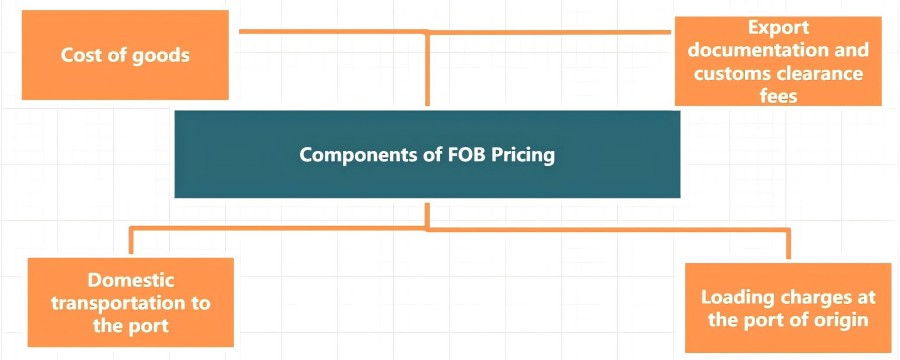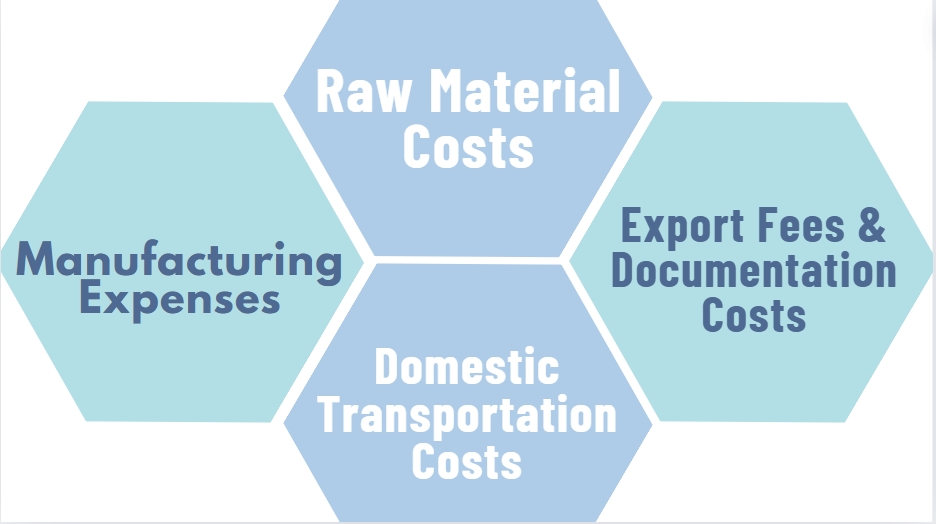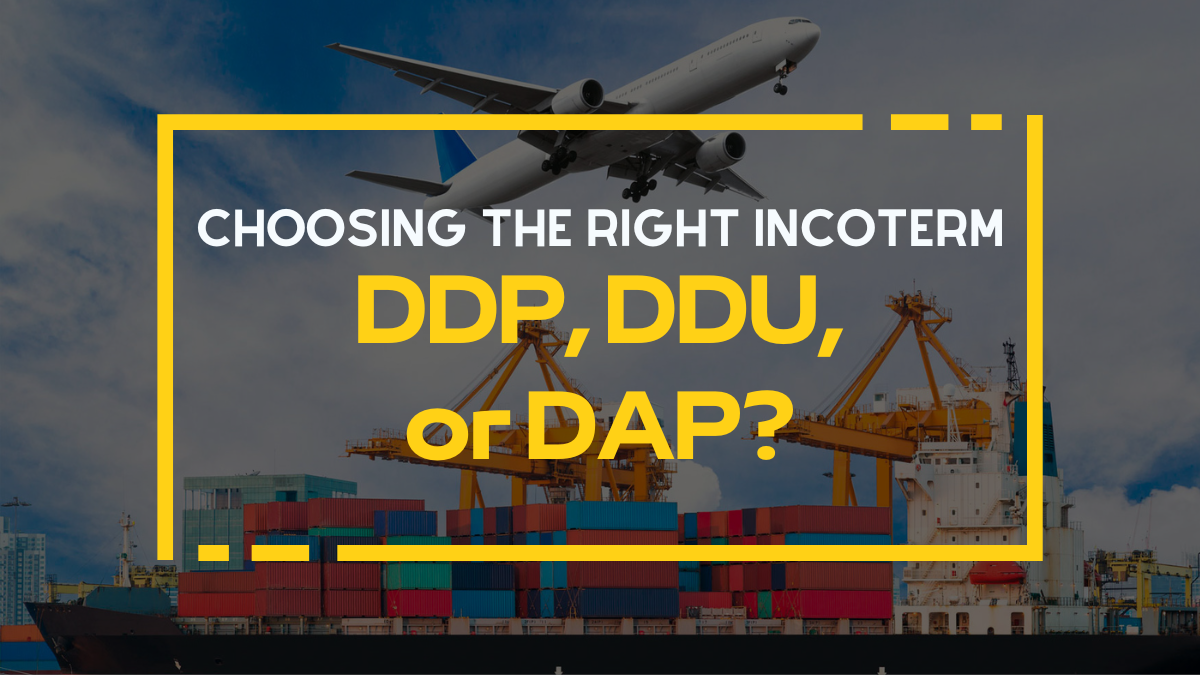Did you know that FOB terms are used in over 60% of international sea shipments? As a manufacturer, understanding FOB is crucial for our B2B operations.FOB, or Free on Board, is a key Incoterm that defines responsibilities in international trade.
It’s significant for bulk shipments and large-scale transactions between businesses. In this article, I’ll explain what FOB means, how it affects both buyers and sellers, and how pricing works under FOB terms. This knowledge is essential for any company involved in global trade.
I. What is FOB?
FOB (Free on Board) terms indicate that the seller fulfills their obligation to deliver when the goods have passed over the ship’s rail at the named port of shipment. At this point, the buyer assumes all risks and costs.
The most common variant is “FOB (named port of shipment),” which requires specifying the port where the responsibility shifts from seller to buyer.
Key Differences:
- FOB vs. FAS (Free Alongside Ship): In FAS, the seller delivers when the goods are placed alongside the vessel at the port of shipment. The buyer is responsible from that point onwards.
- FOB vs. FCA (Free Carrier): In FCA, the seller delivers the goods to a carrier or another party at a specific place, not necessarily at the port. This term can apply to any mode of transport.
II. Responsibilities Under FOB

(1) Seller’s Obligations
As a seller, our responsibilities include:
- Goods Provision and Export Packaging: The seller must ensure that goods are properly packaged for export to prevent damage during transit.
- Export Clearance and Documentation: The seller is responsible for obtaining all necessary export licenses and completing export customs procedures.
- Loading Goods onto the Vessel: The seller must load the goods onto the vessel nominated by the buyer at the agreed port of shipment.
- Proof of Delivery: The seller provides proof that the goods have been loaded, such as a bill of lading.
(2) Buyer’s Obligations
Buyers are responsible for:
- Payment for Goods: The buyer pays for the goods as per the contract terms.
- Freight and Insurance Arrangements: The buyer arranges and pays for the shipping and insurance from the port of shipment.
- Import Clearance and Duties: The buyer is responsible for clearing the goods through import customs and paying any associated duties and taxes.
III. Risk Transfer in FOB
Precise Moment of Risk Transfer:
In FOB (Free on Board) transactions, the risk transfers from the seller to the buyer the moment the goods pass the ship’s rail at the port of shipment. This is a critical point in the shipping process, as it delineates where the seller’s responsibility ends and the buyer’s begins.
For example, if any damage occurs to the goods while they are being loaded onto the vessel or once they are on board, it is the buyer’s responsibility. Conversely, if damage happens before the goods cross the ship’s rail, the seller bears the responsibility.
Implications for Insurance and Liability:
Since the buyer assumes the risk after the goods pass the ship’s rail, it is crucial for buyers to arrange appropriate insurance coverage. This coverage should account for potential damages or losses during sea transit.
Liability implications are significant. The seller must ensure the goods are adequately packed and loaded correctly to minimize risk during loading. If the seller fails to do so and the goods are damaged before crossing the ship’s rail, the seller could be liable.
Buyers need to understand their responsibilities regarding the insurance policy. Inadequate insurance can result in substantial financial losses if goods are damaged or lost at sea.
Exceptions and Special Cases:
In some scenarios, the standard FOB terms might be modified through mutual agreement. For instance, parties might agree that the seller retains responsibility for the goods until they are safely stowed in the vessel’s hold.
Special cases may also arise in multimodal transport where the risk might transfer at a different point. For example, when goods are transported using multiple carriers or modes of transport, the risk might transfer when goods are handed over to the first carrier rather than at the port.
It’s essential to clearly document any deviations from standard FOB terms in the contract to avoid disputes. Both parties should be explicit about when and where the risk transfer occurs and what responsibilities each party holds.
IV. FOB Pricing Structure
Understanding the FOB pricing structure is vital for both buyers and sellers. The FOB pricing structure is complex and includes several components that manufacturers and buyers need to understand. Let’s break it down:
Components of FOB pricing:
- Cost of goods – This includes raw materials and manufacturing costs
- Domestic transportation to the port
- Export documentation and customs clearance fees
- Loading charges at the port of origin

Several factors influence FOB prices:
Raw material costs fluctuate based on market conditions, affecting the base price.
Manufacturing expenses include labor, overhead, and production costs, which vary depending on the complexity of the product.
Domestic transportation costs depend on the distance to the port and the mode of transport used. Fuel prices and local logistics infrastructure also play a role here.
Export fees and documentation costs can vary significantly between countries and even ports. These include customs clearance fees, inspection charges, and paperwork processing costs.

To calculate an accurate FOB price, we follow these steps:
- Determine the production cost, including materials and labor
- Add domestic transportation expenses to the port
- Include all export-related costs (documentation, customs, etc.)
- Factor in a profit margin to ensure business sustainability
It’s important to note that FOB pricing typically results in a higher price than Ex-Works (EXW) because it includes more services. However, it often provides better value for buyers who prefer not to handle the complexities of export procedures.
For bulk orders, economies of scale can significantly reduce the per-unit FOB price. This is because many of the fixed costs (like documentation fees) are spread over a larger quantity of goods.
V. Advantages of Using FOB
Using FOB (Free on Board) Incoterms offers significant benefits to both exporters and importers, providing a clear division of responsibilities and risks.
Benefits for Exporters
Exporters benefit from reduced liability and risk under FOB terms. Once the goods are loaded onto the shipping vessel at the port of origin, the seller’s responsibility ends. This clear point of transfer minimizes the seller’s exposure to potential transit-related issues beyond the loading point.
Additionally, managing logistics up to the port simplifies the exporter’s operations. They control the quality and timing of the packaging, transport to the port, and loading onto the vessel, ensuring that these processes meet their standards and reduce the likelihood of disputes.
Benefits for Importers
Importers gain greater control over shipping arrangements under FOB terms. By assuming responsibility once the goods are loaded onto the vessel, buyers can select their preferred carriers and negotiate shipping and insurance terms that best meet their needs.
This control can lead to cost savings, as buyers can shop around for the most competitive freight and insurance rates. Furthermore, importers can coordinate the arrival of goods with their inventory management systems, optimizing their supply chain efficiency.
| Aspect | Buyers | Sellers |
|---|---|---|
| Cost Control | Buyers can negotiate better shipping and insurance rates, potentially leading to cost savings. | Sellers can simplify pricing by transferring shipping costs and responsibilities to the buyer, focusing on production. |
| Risk Management | Buyers assume risk after goods are loaded, enabling them to choose appropriate insurance coverage. | Sellers limit their liability for goods during transit, reducing the chances of claims and disputes. |
| Operations | Buyers gain greater control over the main leg of transportation, coordinating with carriers for timely deliveries. | Sellers streamline their logistics by handling only the initial transport to the port and loading the goods. |
| Flexibility | Buyers can select preferred carriers and manage shipping logistics according to their needs. | Sellers transfer goods at the port of origin, avoiding complexities of international shipping regulations. |
Risk Management Aspects
FOB terms facilitate effective risk management for both parties. For exporters, the risk is confined to the pre-shipment phase, allowing them to focus on ensuring goods are properly prepared and loaded. For importers, knowing the exact point at which they assume responsibility enables them to arrange appropriate insurance coverage from that point onward. This clear delineation of risk helps prevent disputes and ensures that both parties are fully aware of their responsibilities, reducing the chances of misunderstandings.
VI. Potential Drawbacks and Challenges of FOB
While FOB terms have clear benefits, they also present some challenges. One major drawback is the potential for misunderstandings regarding the point of risk transfer. Since risk passes to the buyer once the goods cross the ship’s rail, any damage or loss during loading falls on the buyer. This can be problematic if the loading process is not properly supervised.
Another challenge is the complexity involved in managing logistics. For buyers, taking responsibility from the port onward requires careful planning and coordination. This can be particularly difficult for companies without extensive experience in international shipping.
There are also risks associated with fluctuating costs. Port charges, freight rates, and insurance premiums can vary, making it difficult to predict the final cost accurately. Additionally, any delays at the port can incur extra charges, which the buyer must bear.
Common misconceptions can also cause problems. For example, some buyers might mistakenly believe that FOB includes insurance or that the seller is responsible for the goods until they reach the destination port. It is essential to have a clear understanding of the terms to avoid such issues.
VII. FOB vs. Other Incoterms
Choosing the right Incoterm is crucial for smooth international transactions. Let’s compare FOB with some other commonly used terms.
FOB vs. CIF (Cost, Insurance, and Freight): In CIF, the seller handles the cost, insurance, and freight to the destination port. The risk transfers to the buyer once the goods are on board. This term is more comprehensive but can be more expensive for the buyer.
FOB vs. CFR (Cost and Freight): CFR is similar to CIF but does not include insurance. The seller pays for the freight to the destination port, and the buyer assumes risk once the goods are loaded. This term provides less security compared to CIF.
FOB vs. EXW (Ex Works): EXW places maximum responsibility on the buyer. The seller’s only obligation is to make the goods available at their premises. The buyer handles all transportation, export, and import duties. This term is beneficial for buyers who have robust logistics capabilities.
FOB vs. DDP (Delivered Duty Paid): DDP requires the seller to handle all responsibilities, including import duties and final delivery to the buyer’s location. The risk and cost are higher for the seller, making this term suitable for buyers who want minimal responsibility.
Each Incoterm has its advantages and drawbacks. When choosing the right one, consider factors such as logistics capabilities, cost control, and risk management. Understanding these differences helps in making informed decisions that align with your business needs.
VIII. How to Negotiate FOB Terms
Preparation: Before entering negotiations, it is crucial to understand the specific responsibilities and costs associated with FOB terms for both parties. Buyers should be aware of the point at which they assume risk and costs, while sellers need to ensure they cover all obligations up to the loading of goods onto the vessel. Both parties should have a clear understanding of the potential costs involved, including transportation, insurance, and port fees. Gathering relevant market data and having a clear budget in mind can provide a strong foundation for negotiations.
Strategies: Effective negotiation requires clear communication and a willingness to find mutually beneficial solutions. For buyers, it is advantageous to negotiate favorable shipping rates and insurance coverage, possibly leveraging bulk purchases or long-term contracts. Sellers, on the other hand, should ensure they outline all included services and any additional costs clearly to avoid misunderstandings. It is beneficial for both parties to agree on detailed terms in writing, including specific responsibilities, timelines, and procedures for handling disputes.
Common Pitfalls: One common mistake in FOB negotiations is the lack of clarity on the precise point of risk transfer, leading to disputes over liability for damages. Both parties should explicitly state this point in the contract. Another pitfall is neglecting to consider potential fluctuations in shipping costs and insurance premiums, which can impact the final cost. To mitigate these risks, both buyers and sellers should regularly review and adjust terms as necessary and include clauses that address unexpected changes in costs.
VX. Conclusion
FOB Incoterms define a clear point of responsibility transfer from seller to buyer, providing a balanced approach to managing costs and risks in international trade. We discussed the definition of FOB, its importance, pricing structure, advantages and disadvantages, comparisons with other Incoterms, and strategies for effective negotiation.
Utilizing FOB terms can streamline international trade operations, offering benefits such as reduced liability for sellers and greater control for buyers. However, it is essential to understand the specific responsibilities and costs associated with these terms to avoid common pitfalls and ensure smooth transactions.
If you’re looking to optimize your international trade processes, consider FOB for your next shipment. For more detailed guidance and assistance with your specific needs, feel free to contact us. Our team of experts is ready to help you navigate the complexities of FOB terms and achieve successful trade outcomes.






